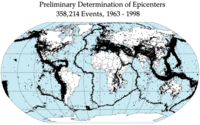
Photo from wikipedia
Abstract The short-lived 182Hf-182W system has been used to constrain the early Earth’s accretion and differentiation. This paper reports high precision W isotopic compositions and trace element concentrations for Archean… Click to show full abstract
Abstract The short-lived 182Hf-182W system has been used to constrain the early Earth’s accretion and differentiation. This paper reports high precision W isotopic compositions and trace element concentrations for Archean (4.0–3.0 Ga) intermediate to felsic rocks from the Slave, North China, and Kaapvaal cratons to discuss early Earth differentiation and mantle mixing processes. The 4.0–3.8 Ga diorite and trondhjemite samples from the Acasta Gneiss Complex (AGC) in the Slave Craton and Anshan Complex in the North China Craton have positive μ182W values ranging from 8.3 ± 3.6 to 14.5 ± 4.0, whereas the 3.36–2.95 Ga TTG rocks from the North China Craton have a uniform modern mantle-like μ182W value of 0.7 ± 3.9 (2 SD, n = 11); with one exception, the 3.32 Ga old sample F28-2, which has a positive μ182W anomaly (7.3 ± 3.9 and 13.0 ± 3.2 for two individual analyses). The Earth’s oldest potassic granites, occurring as conglomerates in the Moodies Group, an intrusive trondhjemite, and an amphibolite with ages of ~3.55 Ga in the Kaapvaal Craton exhibit W isotopic compositions indistinguishable from what is proposed for the modern mantle. The positive 182W anomalies in the 4.0–3.8 Ga rocks could possibly be the result of either early mantle differentiation that occurred within the lifetime of 182Hf or a partial lack of late accreted material. The signature of 182W excess in the 3.32 Ga sample (F28-2) is inherited from earlier crust, presumably similar to the 3.8 Ga TTGs, either by melting or crustal contamination. The transition in μ182W values from positive to near-zero would indicates that a significant event occurred at ∼3.6 Ga which caused efficient mixing of early differentiated mantle and late accreted material, possibly indicating the transition of tectonic regimes from plume to plate tectonics on the Earth.
Journal Title: Geochimica et Cosmochimica Acta
Year Published: 2020
Link to full text (if available)
Share on Social Media: Sign Up to like & get
recommendations!